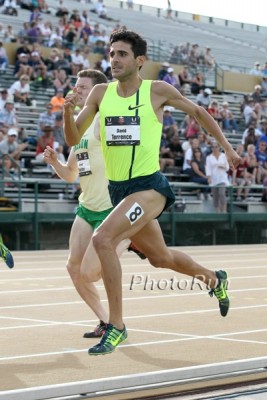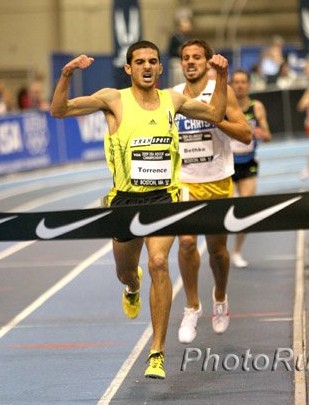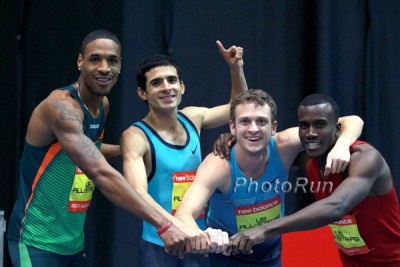Q&A: David Torrence Talks About Why He’s Switching Nationalities to Peru, Seb Coe’s Criticism and Why He Wants to Run the 800/1500 Double in Rio
By Jonathan Gault
June 3, 2016
On Thursday, mere hours before David Torrence ran the 800 at the Adrian Martinez Classic in Concord, Mass., he received the news he had been waiting for: the International Olympic Committee had officially approved his request to compete for Peru at this summer’s Olympic Games in Rio. It marked the culmination of a process that began 11 months ago at the Pan American Games in Toronto, when José Quiñones, the president of the Peruvian Olympic Committee, reached out to Torrence, who earned the silver medal in the 5,000 there competing for the U.S., about switching nationalities. Torrence must wait one year since he last competed for the U.S. before representing Peru, but since the Pan American Games 5,000 final was held on July 25, 2015, and the track and field portion of the 2016 Olympics doesn’t begin until August 12, he is in the clear.
I caught up with the 30-year-old Torrence over the phone on Friday to discuss why he decided to compete for Peru, IAAF president Seb Coe’s criticism of athletes switching nationalities and why Torrence wants to run the 800/1500 double in Rio.
Talk about this development on our word famous fan forum / messageboard: MB: David Torrence request to compete for Peru granted!
When did you become a Peruvian citizen?
I’ve had Peruvian citizenship since the beginning of this year but it was something that was always available to me, just we missed on opportunities. If I had been under 18 and I had just been registered at the Peruvian embassy, I would have been granted citizenship immediately, no problem. But because I was over 18, I actually had to go out to Peru and do some paperwork. I did that this past fall and was able to get [the citizenship] like around February/March.
How do you qualify for it?
My mother’s Peruvian, she was born and raised there. She’s a dual citizen herself between Peru and U.S. She immigrated to the U.S. when she was in high school, so she’s always had Peruvian citizenship. As long as you have one parent that has citizenship, that’s how you get citizenship.
When did you first have the idea of switching to Peru?
I actually had the first idea of doing it back in 2008 when I first graduated from college. At the time, I was unsponsored and didn’t really have a training group or anything and I was looking into what opportunities there were in general. Then I joined John Cook’s group and I got sponsored by Nike and all these things and had a bit of a group out in the Bay Area.
At the time, I had talked to basically the wrong people about running for Peru. I was told I had to live out there for several years. With this new coaching situation and with my sponsor, I didn’t feel like that was going to be possible. I kind of put it on the back burner because I always knew I wanted to run for Peru eventually. But that wouldn’t have been a smart move just as I got started with this new group.
It kind of resurfaced last year at the Pan Am Games when I actually talked to the Peruvian Olympic Committee president. He informed me that the information I received earlier was incorrect or maybe the rules had changed, but that basically he would let me run for Peru. We explored the opportunity, and looked at everything that required, that the timeline and everything would work and it did and it could and so we decided to go with it.
If anything, I definitely planned on running for Peru by 2020, or by 2019 since the Pan Am Games are going to be in Peru. But this kind of pushed it [forward] a cycle because we were able to do it so quickly.
Why run for Peru as opposed to trying to make the U.S. team? Because you competed for the U.S. last summer.
Yeah. I competed for the U.S. a few times. And I had some soul-searching for sure. The question finally came up, like, “Okay this opportunity is available to you, what do you think?” I had to really sit down and think to myself, ‘Why do I do what I do?’ And obviously a big part of it is to see my own personal potential and how fast I can run and actually compete. But another big part of it is inspiring other people and athletes, non-athletes and kids. I kind of realized that whether or not I make the U.S. team, the American public as a whole is going to have heroes to look up to. The U.S. can send a full team in the 1500, a full team in the 5k, a full team in every sport across the Olympic Games, right? It’s expected of Americans to be there
Whereas in Peru, they only have a handful of athletes. I think there’s 12 track athletes now, maybe under 20 in total across all sports (25 according to this article). So me running for Peru and being someone who can make a final in events that Peruvians typically have not been good at, I really hope to have a much greater impact on that population, on those people, on those kids and I can hopefully change the running culture out there a little bit and also kind of introduce the idea of professional track because it’s really not well-known, the sport. Yeah, they have good marathoners, good 10k runners but mid-distance and opportunities for people that are over 25 is very foreign for them. I just feel like I’m much more impactful as Peruvian athlete than as an American athlete, basically.
I know a lot of people are going to say “Oh he’s going the easy route and that’s why he wants to go for Peru.” And yeah, I’ll acknowledge that getting to the Olympics now is a much easier task. But if anything, that (challenge) made me want to run for the U.S. even more. That was actually the main thing preventing me from really committing for a while was because I hadn’t done it for the U.S. and as someone that’s highly, highly competitive with myself and with others, I wanted to do it the hard way.
Do you speak Spanish?
I would say I’m about 95% fluent. When I was young, first of all, I would go back to Peru every other year growing up. Most of my mom’s family is still back in Peru. So I grew up going there speaking Spanish with my family and my mom. When I was about six years old, my father passed away. My father was American, my mom was Peruvian. When he passed away, I was really raised by the Peruvian side of my family. Every day after school, I would go to my grandma’s place while mom was working and it was almost like a little Peru there. She only spoke Spanish, we ate Peruvian food, listened to Peruvian music. I definitely have a very strong tie to my Peruvian heritage and as a result of that upbringing, I’ve always considered myself Peruvian-American and not just American.
I was looking into how an athlete would go about switching citizenship and it looked like the period generally is three years (before you can represent another country) but you can get it reduced to one by either having approval from USATF or the IAAF. I’m wondering how you got the period down to one year in your case.
Basically, Peru wanted me to run for them and they requested that of IAAF/IOC, for them to recognize that. And then secondly, the other part of that was the U.S. had to release me. And if the U.S. didn’t release me then yes, that’s like a three-year wait etc. But the U.S.’s policy is that they will release anyone that wants to represent another country. So I had no problems at all, USATF was very helpful in the process. They wished me the best. I had the release from them and with that release and Peru requesting this change and myself, the IOC looked at all parties involved and granted the approval for the change.
Were there any hurdles in the process, any point where it looked like it wasn’t going to happen?
I would say no. Everything went pretty smoothly. The only thing I was worried about was seeing Seb Coe’s comments about how he wants people to not change countries. And I thought like, you know, what if I’m going to be that first person he makes an example out of? So even though this process had kind of been going on for a while now, I didn’t want to announce it until it was 100 percent confirmed.
In regards to Seb’s comments, I think we need to take a more nuanced view of this. Because my first U.S. team was actually as an 18-year-old kid freshman year in college. I made the World Junior team [in 2004] and ran the 15 there. And is it really fair for junior/youth athletes to decide where they’re going to compete for the rest of their career? A lot of things change, a lot of things happen in people’s lives.
I know a lot of people credit a lot of America’s resurgence to Bernard Lagat coming over to the U.S., having to compete against him and raise their game to try and dethrone him. So hopefully I can go to Peru and not just race them and beat them, but I want to help bring those guys to my level and beat me if they can. I’d love it to train someone out there and get them to attain levels that they wouldn’t have otherwise.
I understand where Seb’s coming from with these country changes that happen with zero ties but I think there is a place for these changes on certain cases.
How specifically would you hope to grow the sport, what would you do to try to grow the elite level in Peru?
I think, first of all, just people seeing an athlete like myself competing at Diamond Leagues, at World Championship races and finals, the Olympic Games hopefully this year, that alone will have people’s eyes on me, and be like “Oh wow, what’s this? I didn’t know people could run that, I didn’t know that was even a part of the Games” because they only watch the marathon and 10k, that’s what’s really known out there, that culture. My presence alone will hopefully make a change.
Secondly, there’s a major, major disconnect between not just Peru, but South America as a whole and the mainstream side of the sport. How often do we see people from South America compete at U.S. meets or European meets? You never see them in the Diamond Leagues, you never see them at these really big invitationals. So I want to help bridge that gap and if guys are getting better and running better, I want to help them achieve that and get them to these meets.
A lot of these athletes and coaches, they only speak Spanish. They don’t have any contact with, or any knowledge of, the U.S.meets, the Canadian circuit, the Belgian circuit etc. So I hope that with my knowledge of the sport from this side, I can help athletes get to races, get an opportunity they may not have had before.
And lastly, I just plan to help share my training. When I’ve been training out there, these guys are super, super talented, they work their asses off and I know they can be world-class. So I hope to go in there and with my knowledge and know-how maybe bring some guys up and maybe have them do some camps up in the U.S. and I’ll have some camps down in Peru. They’ve never been to Flagstaff, they’ve never been to Park City or anything. They just train only in Peru and if you’re the best guys in the world, everyone’s traveling to train somewhere. Not only is it monotonous to train in one place all year round, which is damaging in itself I believe, but you also get certain benefits from going places and learning new things and competing in new places.
Did you ever consider backing out and deciding to do the Trials for the U.S. this year? There aren’t many men with the Olympic standard in the 1500 in the United States right now.
Yeah, I mean right now I have the fastest time in the U.S. in the 15 (3:36.06 at Swarthmore on May 16). And that obviously has been a little bit on my mind knowing that, wow, yeah, the time that I’m switching may have been shaping up to be the time that I had the best shot. But all that being said, like I said before, whether or not I make that team this year for the U.S., I would just have so much more impact running for Peru and that’s really why I stuck with that decision. And I feel like it’s the best choice for me and the people who helped get me to this point.
We spoke yesterday [at the Adrian Martinez Classic], and you said you’re focusing on the 800/1500. If you got the standard in the 800 as well, would you try to do both events in Rio or would you try to do just one? What’s your mindset on that?
I would definitely double in the 8/15 once I get the 800 standard. I feel like I’ve been really close to making these teams and in my mind I’ve always thought of myself as a potential finalist at a Worlds or Olympic Games. Doing the double will help me get a little more experience.
And also, I feel like I have unfinished business in the 800. I almost feel like my first fast 5k I ran in 2012 (13:16 at Payton Jordan) was almost a bit of a — not a curse — but it just kind of shifted everyone and myself’s view of my abilities a little bit. Like, “Oh wow, David can run a fast 5k, you should move up, you should move up.”
But I always felt that I was a fast 800 runner as well. I ran 1:45 in 2011 off of very little 800-meter work and I’ve always felt that, yeah, once I get some more specific interval work, I can really get down there. But the idea that oh speed kills, speed kills, I’ve kind of succumbed to that and was focused a little bit higher up.
But now that I’m running for Peru, I now have the ability to really focus on my own personal development. So I’m really excited to go back to the 800 here in a little bit and get back to that speed that I know I’ve always had but just haven’t been able to get back to because I haven’t really focused on [it] since 2011.
Will it be hard for you not to not commpete at the US Olympic Trials this summer?
Of course, of course. The U.S. championships have been a part of me for a long time and it’s been a major focal point every year. Yeah, I’m going to look at those races and especially depending on how it goes, wonder how I would have done in there. But at end of the day, it’s something that you can’t really focus on too much. Like I said, I made my decision and I’m really happy with it. I’m very proud to represent Peru, I’m very excited. My family is, my friends, other Peruvian athletes I’ve talked to are all very excited for me. So despite missing that experience of the Trials and the U.S. championships, I have this whole new experience to look forward to and I wouldn’t trade it for anything else.
Talk about this development on our word famous fan forum / messageboard: MB: David Torrence request to compete for Peru granted!



